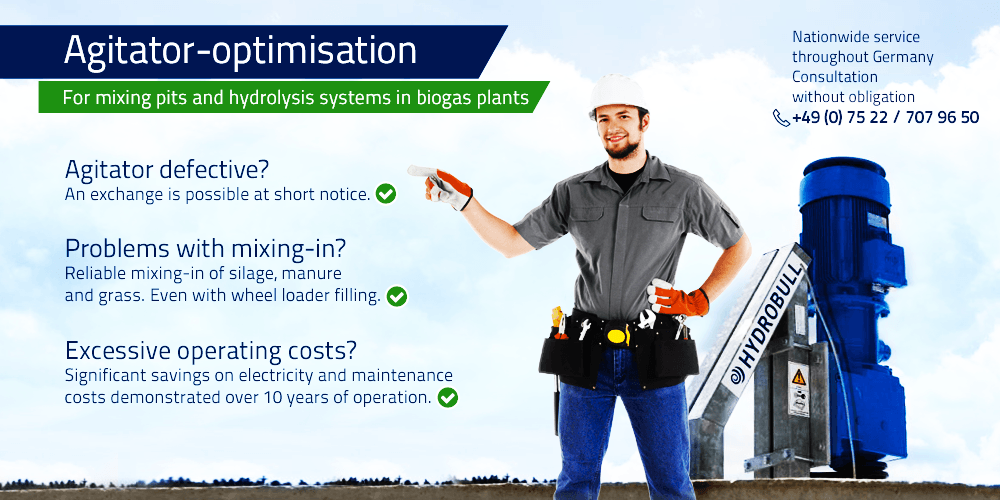Is your agitator in the pre-pit or hydrolysis system defective?
Significant savings on repair, wear and electricity
by optimising agitators in your biogas plant
Then get in touch with us!
Robust and efficient agitators for pre-pits and hydrolysis systems
Very often, agitators are installed in the pre-pits and hydrolysis systems of biogas plants which lead to high operating costs and problems with operation:
- High operating costs
- Due to agitator technology that is prone to defects in the pre-pit or hydrolysis system
- Due to the high self-generated energy consumption of fast-running units > 200 rpm
and dosing technology on the upstream side - Due to wear and maintenance costs every 2 - 5 years
- Only limited processing of "pourable" silage, which is expensive
- Low-cost materials such as manure, grass, residual fodder and other residues are often unable to be processed by the mixing-in system
- Low-cost materials such as manure, grass, residual fodder and other residues are often unable to be processed by the mixing-in system
- A high "water" consumption in the form of recirculation or water, because the agitators cannot operate otherwise
- Often, the dry matter content is limited to max. 10% dry matter due to fast-running agitators
- Excessive recirculated material means the high pH value has a negative effect on the hydrolysis and gas yield
As a user of more than 2500 agitators involving different systems such as submersible agitators, long-axis agitators, rod mixers and special agitators, our experience definitely shows that fast-running units in pre-pits and hydrolysis systems are simply a waste of money!
Many concepts use at least one fast-running unit in the pre-pit or hydrolysis system, thus generating enormous electricity consumption and wear.
Quite specific agitator systems for pre-pits and hydrolysis systems have been developed in the form of the slow-running Maischebull and the Hydrobull system:
Many years of experience with pre-pits and hydrolysis systems in biogas plants
In 2004, we set ourselves the target of solving these problems in pre-pits and hydrolysis systems for good and all!
In more than 10 years of operation in mixing pits / hydrolysis systems, the following results have been achieved:
+ Almost maintenance-free operation without changing the propeller, main shaft or base bearing over these 10 years
+ Reliable mixing-in of all kinds of raw materials, above all inexpensive raw materials such as manure, grass, fodder residues & by-products
+ Direct wheel loader filling (it goes without saying that a doser can also be used)
+ Achievement of a thick suspension with dry matter content significantly above 10% and saving of recirculated material, giving faster and improved acidification and more biogas in the fermenter
+ Low electricity consumption because of slow-running Maischebull or Hydrobull agitators
These are the possibilities of the patented Maischebull system for mixing pits and Hydrobull for hydrolysis systems or larger mixing pits. Both systems have proven themselves for years in all kinds of biogas plants worldwide.
Process the inexpensive raw materials of your choice and reduce your feeding costs significantly!
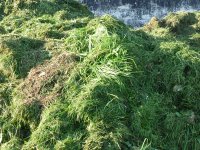
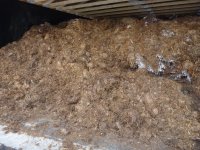
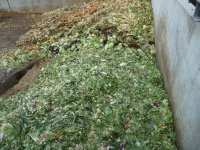
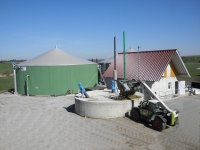
Your financial benefits from optimised operation of your pre-pit or hydrolysis system
Owner/operators are changing over to electricity-saving, low-wear and durable operation in their agitator technology.
| Make the comparison yourself: Save money during dosing and hydrolysis rather than wasting money: | ||
Operating costs - area |
Previous operation, 230 m³
|
Operation with Hydrobull, 230 m³
|
| Agitator system: | Pushing floor doser 1 fast-running agitator 1 paddle stirrer |
Pushing floor doser is dispensed with, |
| Electricity costs of doser: |
5,440 € / year |
0 € / year |
| Electricity costs of agitators: | 20,400 € / year (20 kW x 6,000 op. hrs. x 0.17 €/kWh) Agitators have to run continuously because of processing grass. |
7,191 € / year* |
| Replacement and wearing parts: |
2,000 € / year |
250 € / year |
| CHP plant capacity utilisation: |
90% = 450 kW |
11,020 € additional yield / year |
| TOTAL operating costs per year: |
27,840 € / year |
7,441 € / year |
Savings in
|
20,399 € / year saving |
|
* The electricity costs have been calculated here for a high dry matter content, this will be optimised individually in your operation depending on viscosity.
The use of less expensive raw materials (manure and other residues) would give rise to further savings.
Often, these cheap substrates could not be processed in the past because of the loading technique.
We will be happy to advise you of your specific operating situation, please give us a call or fill in the response box!
Here, you can see the current comparison between different agitator systems for pits and hydrolysis systems in biogas plants:
pdf - download "Agitator technology for pits and hydrolysis systems"
Source: Ratgeber Energie (energy adviser), special publication by BAUERNZEITUNG, Deutscher Bauernverlag Berlin, www.bauernzeitung.de
What do biogas owner/operators have to say? Experience with Maischebull and Hydrobull.
Tannhausen BGP 570 kW = More than 6,000 € savings in electricity costs annually
Mr. Abele uses the Hydrobull system. He equipped his biogas plant with a hydrolysis system right from the start.
This was originally provided with fast-running submersible motor agitators for mixing.
However, this technology revealed its disadvantages even during the first operating year, such as a high quantity of recirculating material and significant electricity consumption.
After only one year in operation, the owner/operator decided to reconfigure and optimise the hydrolysis system by converting to the slow-running Hydrobull system.
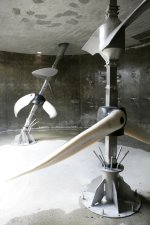
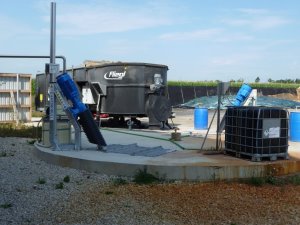
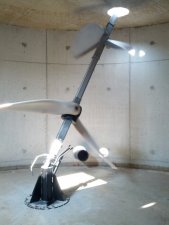
Since then, the plant has been operating with stable loading and good CHP plant capacity utilisation.
It has been possible to reduce the quantity of recirculating material significantly.
More than 6,000 € of electricity costs have been saved annually since the optimisation.
Gera BGP, power increase from 250 kW to 500 kW = without additional fermenter investment
"Our goal was to double the output by adding an additional mixing pit.
We had an hydrolysis system with 225 m³. We want to have a homogenous mash and optimum hydrolysis.
The whole thing should function reliably and without problems. Maischebull and Hydrobull are top technologies, they function reliably and save electricity" Mr. Ullrich, owner/operator
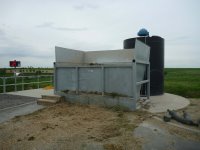
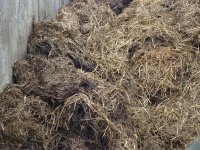
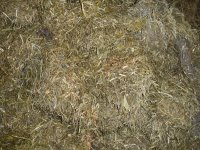
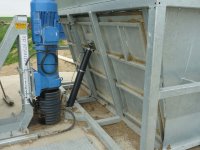
Gera processes solid manure, dry chicken faeces, grass silage, maize silage and a minimum proportion of cereal. It is loaded into the pre-pit directly through the feed hopper by wheel loader.
The Maischebull agitator mixes the added material into the recirculating material.
Schleswig BGP = Conversion to optimum hydrolysis
At present, a conversion and optimisation to two-stage hydrolysis operation is in progress for an existing biogas plant.
Previously, the fermenter was loaded directly.
What are the differences between Maischebull and Hydrobull?
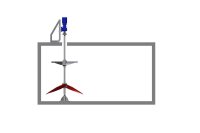
The Maischebull agitator is used for pre-pits and mixing pits as an individual agitator..
Dosing can take place directly from the wheel loader bucket or from the solids metering unit.
The Maischebull is a classic slow-running unit with a rated speed of only 38 or 55 rpm. Manure, grass, silage and other substances are drawn in automatically by the Maischebull and intermixed.
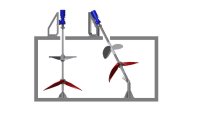
The Hydrobull system features two slow-running agitators.
The Hydrobull system is used for larger pre-pits and for hydrolysis systems.
Here too, direct loading from a wheel loader or a doser is possible.
Alternatively, the hydrolysis system can be operated as an independent container without solid material loading.
Frequent questions by owner/operators prior to converting the pre-pit or hydrolysis system
Is one agitator really enough for the pre-pit or mixing pit (Maischebull)?
The powerful Maischebull agitator is quite sufficient for a classically equipped mixing pit with 100 to 130 m³.
The powerful vertical thrust effect downwards means that it can mix in all kinds of substrates outstandingly effectively.
The appropriate drive concept is configured depending on the properties of the substances (silage, manure, grass) and the viscosity. Most owner/operators then optimise the rotation speed and operating time during operation so as to run with a minimum electricity consumption.
Up to now, I have had 2 agitators in my mixing pit/hydrolysis system; can I exchange only one agitator for the Maischebull agitator?
Basically, it goes without saying that a combination with other agitator types is possible if the existing agitator is still functioning well and achieving good mixing results.
We will be happy to check this for you, please simply give us a call or fill in the request box.
We need to know the container dimensions and the figures for the existing agitator.
Are open pits without a concrete lid also suitable for the Maischebull or Hydrobull system?
Yes, we can also position the agitators accordingly for optimum results even from the outside through the container wall or using a steel console.
Pits with a lid comprising a steel fabrication can also be converted to use with slow-running units accordingly.
Do I have to make any adjustments to the agitators?
No, the arrangement of the agitators and also the position and number of the propellers is configured by us precisely for your requirements.
This ensures that good mixing-in and agitator effect is achieved with minimum energy expenditure, whatever the fill level.
How long will the agitator last?
The first Maischebull agitators have been in use under tough every day conditions since 2004.
They are still running with the propellers, shafts and base bearings that they were first fitted with.
This is possible because of the selection of materials with high wear-resistant properties and the principle of the "slow-running agitator".
We recommend draining the pit every couple of years so as to remove sedimented interfering materials (pump protection).
The agitator should also be checked at the same time.
What are the main wearing and replacement parts?
Our experience shows that the operational expenditure here is really quite modest.
Each agitator is fitted with a mechanical overload protection device.
These shear pins and the clutch disc are the only replacement parts that the owner/operator will need.
The costs are about 35 € per shear pin and 124 € for a clutch disc.
Replacements will only be required 1 - 3 times a year, and only then if operating conditions are highly demanding.
This results in annual costs ranging from 194 - 582 € net. However, these will not necessarily be required.
If the system is run less "strenuously", there will be no expenditure on these parts at all.
As with all other agitators, the oil in the drive will have to be changed at certain intervals.
However, this can be accessed conveniently above the pit because the drive is on the outside.
How can I finance an agitator exchange?
If your agitator is defective and you want to change over to the Maischebull or Hydrobull system, or if you want to change over your existing agitator system for reduced operating costs, several financing opportunities are available to you:
- Perhaps you have insurance against machine breakage, and you can cover the replacement investment by means of this insurance
- Perhaps you can finance the refurbishment of the agitator technology from reserves accrued from your biogas operation
- Perhaps you can finance the refurbishment with a loan from your principle bank, explaining to them the commercial and operational advantages (reduced wear and electricity costs, higher CHP plant capacity utilisation, possibly saving in raw material costs by changing over to manure, dry chicken faeces, grass or other inexpensive residues)
List of sources:
Image license according to license conditions of Fotolia for the integrated photo in the top banner | Fotolia.de

